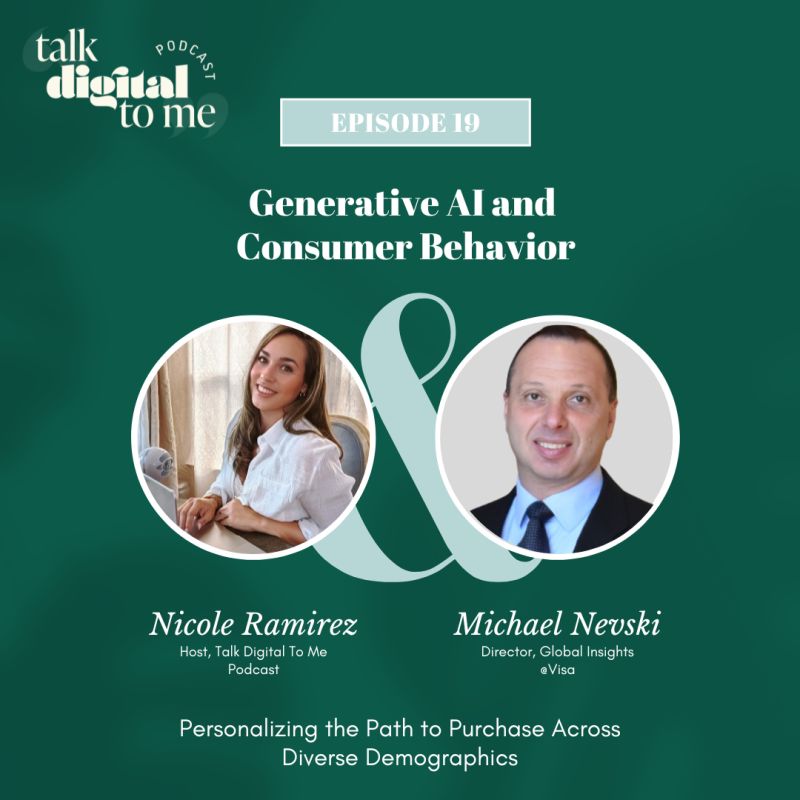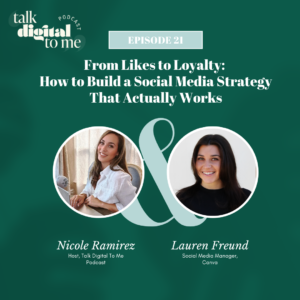Listen to the podcast:
Below are key insights and actionable takeaways from our conversation.
Key Takeaways
1. Generative AI: A Game-Changer for Marketers and Consumers
Generative AI uses large language models to interact with humans, create content, and analyze complex data patterns. Michael highlighted its transformative impact:
- Streamlining processes like fraud detection and content creation.
- Delivering real-time consumer behavior insights.
- Offering hyper-personalized marketing experiences.
Generative AI marks a shift from “revolution to evolution,” requiring businesses to adapt to these advancements.
2. Understanding the Four Types of Generative AI Users
Michael identified four key consumer segments leveraging generative AI:
- Heavy Users: Daily adopters deeply engaged with AI tools.
- Creative Users: Individuals seeking inspiration and generating visual content.
- Learners: Professionals using AI to develop skills.
- Efficiency Seekers: Consumers streamlining their daily lives with AI.
Approximately 25% of U.S. consumers already rely on generative AI for tasks like product research and decision-making, underlining its growing influence on purchasing behavior.
3. Building Trust in AI Adoption
A trust gap exists, as consumers tend to trust companies behind AI tools more than the technology itself. Michael emphasized that businesses can bridge this gap by:
- Clearly communicating data privacy and governance policies.
- Ensuring ethical AI usage.
- Actively addressing issues like security and AI-generated errors.
4. Personalization at Scale with AI
Generative AI enables real-time, mass customization by collecting data across touchpoints, allowing marketers to:
- Build nuanced customer personas.
- Adjust campaigns instantly.
- Deliver hyper-personalized experiences.
This enhanced personalization fosters stronger connections with diverse audiences, driving engagement and loyalty.
5. Enhancing Emotional Connections with AI
While AI drives efficiency, it cannot replace human touch. Michael suggested building systems that balance technology and emotional intelligence by:
- Transitioning frustrated users to human agents.
- Identifying consumer preferences for human interaction over automation.
6. Starting Small with AI Adoption
For businesses beginning their AI journey, Michael provided practical advice:
- Explore free or low-cost tools to test AI capabilities.
- Train staff to integrate AI into workflows effectively.
- Develop phased plans for short-, medium-, and long-term AI adoption.
7. Future Trends in AI-Driven Marketing
Michael highlighted transformative trends shaping the future of AI in marketing:
- Hyper-Personalization: Delivering precise, targeted experiences.
- Behavioral Analytics: Leveraging real-time feedback to refine strategies.
- AI-Driven Creativity: Generating dynamic images, videos, and campaigns.
- Ethical AI: Building trust through transparent and responsible practices.
Quotes from Michael Nevski
On Consumer Insights and Marketing Strategy
“Marketing insights identify white spaces and help companies cater to changing consumer preferences and tastes.”
“Insights are like the neck, guiding the head to look in the right direction to identify opportunities.”
On Generative AI’s Potential
“Generative AI enables marketers to be more efficient while helping consumers save time and organize their lives.”
“It’s not just a revolution—it’s an evolution in how consumers and businesses interact with brands.”
On Trust and AI
“Consumers trust companies behind generative AI more than the technology itself by a 10-percentage-point margin.”
“Transparency and ethical use are crucial for building consumer confidence in AI.”
On Personalization
“Real-time data allows marketers to adjust campaigns immediately, delivering hyper-personalized experiences.”
Looking Ahead
Generative AI represents immense opportunities for businesses to revolutionize marketing and consumer interactions. By prioritizing personalization, fostering trust, and balancing technology with emotional connection, marketers can leverage AI to create meaningful, scalable impact.
As Michael concluded:
“The future is incredibly exciting for both marketers and consumers. Generative AI is not just a tool—it’s a catalyst for meaningful connections and growth.”
What excites you most about generative AI’s potential in marketing? Share your thoughts below!





